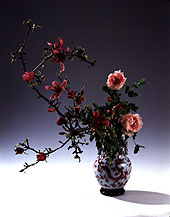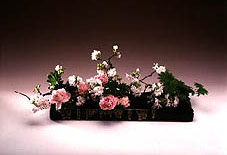WHAT IS IKEBANA?
|
Over the seven centuries of its evolution, ikebana has developed many different styles of arrangement. Among the most common are the rikka (standing flowers), seika or shoka (living flowers), and nageire (flung flowers) styles when making arrangements in bowl-shaped vases and the moribana (piled-up flowers) style when using dish-like containers.
The choice of what flowers to arrange is guided by the desire to create harmony between flower and container and to find flowers that blend in well with its surroundings. Although layer after layer of flowers are used in Western floral arrangements, in ikebana, the key consideration is to use as few stems and leaves as possible in composing elegant contours that highlight the flowers' beauty.
Some schools of ikebana have begun incorporating Western approaches (like the hanaisho style of the Ohara school). But even then, there are no dense layers of flowers, as in Western styles; the arrangements are imbued with an Eastern view of nature and incorporates the space around the flowers to strike a perfect balance among the elements.
|

Photos: (Top) Heika; (middle) moribana; (above) Hanaisho (Photos courtesy of Ohara School of Ikebana.) |
 Ikebana is the art of beautifully arranging cut stems, leaves, and flowers in vases and other containers that evolved in Japan over seven centuries. To arrange the stems and flowers exactly as one wishes, a familiarity with many different ways of fastening and positioning them is necessary. These techniques are what people attend ikebana classes to learn. Usually, three to five years are required to acquire these technical and expressive skills.
Ikebana is the art of beautifully arranging cut stems, leaves, and flowers in vases and other containers that evolved in Japan over seven centuries. To arrange the stems and flowers exactly as one wishes, a familiarity with many different ways of fastening and positioning them is necessary. These techniques are what people attend ikebana classes to learn. Usually, three to five years are required to acquire these technical and expressive skills. Traditionally, arranged flowers were decorated in the toko-no-ma--the alcove in rooms where guests were normally received. Today they are also frequently seen in entrance halls and living rooms, as well as in lobbies of large buildings and shop windows.
Traditionally, arranged flowers were decorated in the toko-no-ma--the alcove in rooms where guests were normally received. Today they are also frequently seen in entrance halls and living rooms, as well as in lobbies of large buildings and shop windows.



